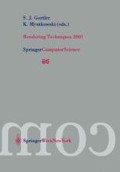Abstract
In this paper a novel from-region visibility algorithm is described. Its unique properties allow conducting remote walkthroughs in very large virtual environments, without preprocessing and storing prohibitive amounts of visibility information. The algorithm retains its speed and accuracy even when applied to large viewcells. This allows computing from-region visibility on-line, thus eliminating the need for visibility preprocessing. The algorithm utilizes a geometric transform, representing visibility in a two-dimensional space, the dual ray space. Standard rendering hardware is then used for rapidly performing visibility computation. The algorithm is robust and easy to implement, and can trade off between accuracy and speed. We report results from extensive experiments that were conducted on a virtual environment that accurately depicts 160 square kilometers of the city of London.
Access this chapter
Tax calculation will be finalised at checkout
Purchases are for personal use only
Preview
Unable to display preview. Download preview PDF.
References
C. Andujar, C. Saona-Vazquez, and I. Navazo. LOD visibility culling and occluder synthesis. Computer Aided Design, 32(13):773–783, November 2000.
F. S. Cho and D. Forsyth. Interactive ray tracing with the visibility complex. Computer & Graphics, 23(5):703–717, 1999.
D. Cohen-Or, Y. Chrysanthou, and C. Silva. A survey of visibility for walkthrough applications. SIGGRAPH 2000 ‘Visibility: Problems, Techniques, and Applications’ course notes.
D. Cohen-Or, G. Fibich, D. Halperin, and E. Zadicario. Conservative visibility and strong occlusion for viewspace partitioning of densely occluded scenes. Computer Graphics Forum, 17(3):243–254, 1998 243-254.
S. Coorg and S. Teller. Real-time occlusion culling for models with large occluders. 1997 Symposium on Interactive 3D Graphics, pages 83–90, April 1997.
M. de Berg, M. van Kreveld, M. Overmars, and O. Schwarzkopf. Computational Geometry: Algorithms and Applications. Springer-Verlag, Berlin, 1997.
F. Durand. 3D Visibility: analytical study and applications. PhD thesis, Université Joseph Fourier, Grenoble I, July 1999.
F. Durand, G. Drettakis, J. Thollot, and C. Puech. Conservative visibility preprocessing using extended projections. Proceedings of SIGGRAPH 2000, pages 239–248, July 2000.
T. Funkhouser. Database management for interactive display of large architectural models. Graphics Interface, pages 1–8, May 1996.
S. J. Gortler, R. Grzeszczuk, R. Szeliski, and M. F. Cohen. The lumigraph. Proceedings of SIGGRAPH 96, pages 43–54, August 1996.
C. Gotsman, O. Sudarsky, and J. Fayman. Optimized occlusion culling. Computer & Graphics, 23(5):645–654, 1999.
N. Greene and M. Kass. Hierarchical z-buffer visibility. Proceedings of SIGGRAPH 93, pages 231–240, 1993.
A. E. Haines and J. R. Wallace. Shaft culling for efficient ray-traced radiosity. 2nd Eurographics Workshop on Rendering, pages 122–138, 1994.
T. Hudson, D. Manocha, J. Cohen, M. Lin, K. Hoff, and H. Zhang. Accelerated occlusion culling using shadow frusta. In Proceedings of the 13th Symposium on Computational Geometry, pages 1–10, June 1997.
V. Koltun, Y. Chrysanthou, and D. Cohen-Or. Virtual occluders: An efficient intermediate PVS representation. 11th Eurographics Workshop on Rendering, pages 59–70, 2000.
V. F. Leavers. Which Hough transform? Computer Vision and Image Understanding, 58(2):250–264, 1993.
M. Levoy and P. Hanrahan. Light field rendering. Proceedings of SIGGRAPH 96, pages 31–42, August 1996.
B. Nadler, G. Fibich, S. Lev-Yehudi, and D. Cohen-Or. A qualitative and quantitative visibility analysis in urban scenes. Computer & Graphics, 23(5):655–666, 1999.
R. Orti, S. Riviere, F. Durand, and C. Puech. Radiosity for dynamic scenes in flatland with the visibility complex. Computer Graphics Forum, 15(3):237–248, August 1996.
M. Pocchiola and G. Vegter. The visibility complex. International Journal on Computational Geometry and Applications, 6(3):279–308, 1996.
C. Saona-Vazquez, I. Navazo, and P. Brunet. The visibility octree: A data structure for 3D navigation. Computer & Graphics, 23(5):635–644, 1999.
G. Schaufler, J. Dorsey, X. Decoret, and F. X. Sillion. Conservative volumetric visibility with occluder fusion. Proceedings of SIGGRAPH 2000, pages 229–238, July 2000.
A. Steed, E. Frecon, D. Pemberton, and G. Smith. The london travel demonstrator. In Proceedings of the ACM Symposium on Virtual Reality Software and Technology (VRST-99), pages 150–157, Dec. 1999.
S. J. Teller. Computing the antipenumbra of an area light source. Computer Graphics (Proceedings of SIGGRAPH 92), 26(2): 139–148, July 1992.
S. J. Teller. Visibility computations in dnsely ocluded plyhedral evironments. PhD thesis, Dept. of Computer Science, University of California, Berkeley, 1992.
S. J. Teller and P. Hanrahan. Global visibility algorithms for illumination computations. Proceedings of SIGGRAPH 93, pages 239–246, August 1993.
M. van de Panne and J. Stewart. Effective compression techniques for precomputed visibility. 10th Eurographics Workshop on Rendering, pages 305–316, 1999.
P. Wonka and D. Schmalsteig. Occluder shadows for fast walkthroughs of urban environments. Computer Graphics Forum, 18(3):51–60, September 1999.
P. Wonka, M. Wimmer, and D. Schmalstieg. Visibility preprocessing with occluder fusion for urban walkthroughs. 11th Eurographics Workshop on Rendering, pages 71–82, 2000.
H. Zhang, D. Manocha, T. Hudson, and K. Hoff. Visibility culling using hierarchical occlusion maps. Proceedings of SIGGRAPH 97, pages 77–88, August 1997.
Author information
Authors and Affiliations
Editor information
Editors and Affiliations
Rights and permissions
Copyright information
© 2001 Springer-Verlag Wien
About this paper
Cite this paper
Koltun, V., Chrysanthou, Y., Cohen-Or, D. (2001). Hardware-accelerated from-region visibility using a dual ray space. In: Gortler, S.J., Myszkowski, K. (eds) Rendering Techniques 2001. EGSR 2001. Eurographics. Springer, Vienna. https://doi.org/10.1007/978-3-7091-6242-2_19
Download citation
DOI: https://doi.org/10.1007/978-3-7091-6242-2_19
Published:
Publisher Name: Springer, Vienna
Print ISBN: 978-3-211-83709-2
Online ISBN: 978-3-7091-6242-2
eBook Packages: Springer Book Archive

